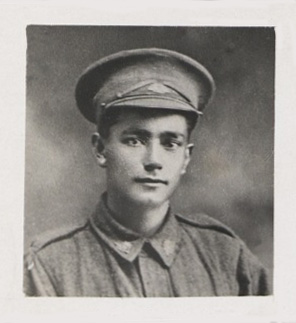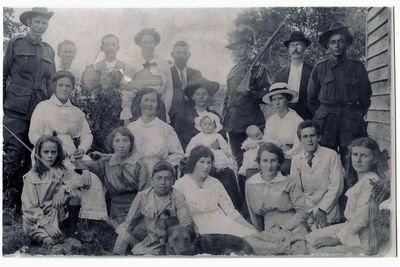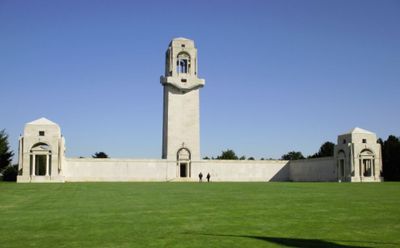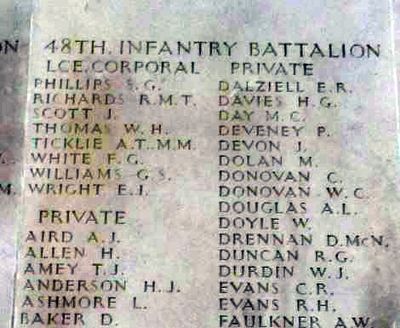Difference between revisions of "Albert Thomas Ticklie MM"
From Our Contribution
| Line 46: | Line 46: | ||
| monument3 = [[Armadale and Districts Roll of Honour]] | | monument3 = [[Armadale and Districts Roll of Honour]] | ||
| monumentnote3 = | | monumentnote3 = | ||
| − | | monument4 = | + | | monument4 = |
| monumentnote4 = | | monumentnote4 = | ||
| − | | monumentawm = | + | | monumentawm = [https://www.awm.gov.au/collection/R1671487 Australian War Memorial] |
| medal1 = [[Military Medal]] | | medal1 = [[Military Medal]] | ||
| medal2 = [[British War Medal]] | | medal2 = [[British War Medal]] | ||
Revision as of 18:07, 16 August 2018
 LISWA Memorial Card 136B/163 | |
 Birtwistle LSL PH582 Albert (right ) at his farewell | |
| Personal Information | |
|---|---|
| Date of Birth | 10 Oct 1889 |
| Place of Birth | Victor Harbour, South Australia |
| Death |
11 Apr 1917 1st Bullecourt "11 Apr 1917 1st Bullecourt" contains more than three components required for a date interpretation. |
| Place of Death | near Reincourt, France |
| Age at Enlistment | 25 years, 11 months |
| Description |
5'7¾" (1.72m) tall ; 144 lbs 65.317 kg ; dark complexion ; brown eyes ; black hair |
| Occupation | Timber hewer |
| Religion | Methodist |
| Address | Seventh road, Armadale, Western Australia |
| Next of Kin | Mother , Mrs J. Ticklie |
| Military Information | |
| Reg Number | 4347 |
| Date of Enlistment | 6 Oct 1915 |
| Rank | Lance Corporal |
| Unit/Formation | 16th Battalion, 13th Reinforcement, transferred to 48th Battalion, B Company, 5th Platoon Bombing Section |
| Date of Embarkation | 29 Jan 1916 ‒ 26 Feb 1916 |
| Ship Embarked On | HMAT A54 Runic |
| Fate |
Wounded in Action 7 Aug 1916 Mouquet Farm Missing in Action, later Killed in Action 11 Apr 1917 1st Bullecourt |
| Monument |
Armadale War Memorial (West Armadale panel) Villers-Bretonneux Memorial Armadale and Districts Roll of Honour Australian War Memorial |
| Medals |
Military Medal British War Medal Victory Medal |
Pre War
In 1911 was known to have been working at Holyoake timber mill. James, his brother James lived in Armadale and Albert used his house as a base for his timber working jobs.
War Service
Two months after entering Blackboy Hill Camp, Albert was allocated to the 18th reinforcement draft for the 16th Battalion, but on arrival in Egypt was caught up in the split of existing infantry battalions to create new ones, and on 1 Apr 1916 transferred from the 16th Battalion at Zeitoun to the 48th Battalion at Serapeum.
On 2 Jun 1916 along with the rest of the 48th Battalion he embarked on the HMT Caledonia in Alexandria for Marseilles where they disembarked on 9 Jun 1916.
The 48th Battalion was involved in heavy fighting at Pozieres where they were heavily shelled on the 5th and 6th of August 1916. Food and ammunition coming forward and casualties going back had to traverse 450 metres of open land. Albert earned his Military Medal for carrying wounded men under heavy machine gun fire, and he paid the price, possibly during the morning of 7 Aug 1916 when the Germans counter attacked those occupying their old trenches. Albert received a GSW to his right thigh.
On 8 Aug 1916 Albert was admitted to the 6th General Hospital in Rouen, and his return to the battalion did not occur until 29 September as he spent 3 weeks in the 4th Division's Base Depot at Étaples. On 4 Oct 1916 he received his Military Medal, and two days later was promoted Lance Corporal.
In April 1917 the 48th Battalion was involved in the attack on the German Hindenberg Line near Bullecourt. Albert was amongst those who had advanced as far as the OG2 line of trenches before receiving a serious wound to his neck. Along with all the other injured, he had to be left behind when the Australian attackers were forced through lack of ammunition to retreat.
Lance Corporal H. Lane 1754 later advised the Red Cross [1].
.."I saw Ticklie lying dead at Bullecourt apparently killed by high explosive. Saw no wound, he was face downward. I did not turn him over but believe he was dead. Others at Headquarters Coy said he was dead. Don't know if the body was brought in, but snow swallowed a lot of the bodies about this time.
Pte A.E. Smith of the 1st Platoon A Company reported...
.."I saw Lance Corporal Ticklie MM. He was I think in B Company and a H.Q. Bomber. I saw him lying very badly wounded on the 2nd German line at Bullecourt on April 11th 1917 about 11:00am. He appeared to be very bad. I spoke to him. He was left behind when we retired about noon. None of our wounded were brought in."
Another report says that he had a leg blown off, while yet another one says the injury was to the throat, and a third says his leg was smashed.
Perhaps 3304 Sgt L. W. Sando should have the final word...
.."On April 11th 1917 I saw Lance Corporal Ticklie in a trench known as the Hindenberg Line about 600 yards to the right of Bullecourt. He was badly wounded in the neck but quite conscious. This was about 11:30 a.m. In my opinion he would be taken prisoner, as we had to retire to another line.....He was hit in the throat with a piece of bomb. He was conscious when we left the trench."
Albert was posted as Missing - Wounded, but a Court of Enquiry, held 29 Dec 1917, on the basis of information gathered declared him to have died of his wounds.
"He went to Egypt and thence to France, where he was wounded at the Battle of Pozieres. Returned to the firing line on 6th August; is Lance Corporal in the 48th, and received Military Medal."[2]
Casualty List 300 includes Lance Corporal A.T. Ticklie of South Australia as Missing.
"Leane's Battalion" page 39 relating to the battle at Pozieres
.." Despite the shelling, stretcher-bearers worked unceasingly to evacuate the wounded men of the 27th Battalion that lay abandoned in the area. The task was hazardous; traversing open ground with heavily laden stretchers and consequently casualties amongst the bearers were extremely high. Throughout the night Privates R. Cleggert and A.T. Tickle crossed open ground between tramway Trench and O.G.1 (a distance of about 400 yards) with wounded men and both were awarded Military Medals. Many other men carried out similar work but did not survive to be rewarded."
In "Leane's Battalion" at page 117 in relation to the battle at Bullecourt, author Neville Browning reports that Tickle was killed during a fierce counter attack by the Germans on O.G.1, and that he was killed by shrapnel wounds to the throat and leg.
Award Comment
Military Medal.
"HIS MAJESTY THE KING has been graciously pleased to award the Military Medal for bravery in the field to the undermentioned non-commissioned officer :- No. 4347,Lance Corporal Albert Thomas Ticklie".Text of award reads:
"At Pozieres on August 5th to 7th, rendered gallant service in the rescue of wounded under intense enemy shellfire. Time after time, he crossed the open country between Tramway Trench and O.G.1 and O.G.2 - a distance of about 500 yards - in order to bring in wounded, and finally he himself was wounded. Even then he was reluctant to give up his efforts."[3][4]
Notes
Memorialised at VILLERS-BRETONNEUX MEMORIAL Son of John and Elizabeth Ticklie, of Encounter Bay, South Australia
- ↑ "Australian Red Cross Wounded and Missing Files - Albert Thomas Ticklie". Australian War Memorial. 2018. Retrieved 2 May 2018.
- ↑ "The Drill of the Foot-Hills" (PDF) (1917). Western Australia. Mar 1917. p. 11. Retrieved 16 May 2017 – via State Library of Western Australia.
- ↑ London Gazette 14 Nov 1916
- ↑ Commonwealth of Australia Gazette No 62 dated 19th April 1917

